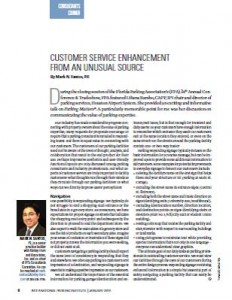During the closing session of the Florida Parking Association’s (FPA) 34th Annual Conference & Tradeshow, FPA featured Liliana Rambo, CAPP, IPI chair and director of parking services, Houston Airport System. She provided an exciting and informative talk on Parking Matters®. A particularly memorable point for me was her discussion on communicating the value of parking expertise.
Our industry has made considerable progress connecting with property owners about the value of parking expertise; many requests for proposals encourage or require that a parking consultant is included in responding teams. But there is equal value in connecting with our customers. The customers of our parking facilities need not be aware of the level of thought, analysis, and collaboration that result in the end product for their use. Perhaps impressive aesthetics and user-friendly functional layouts are only discussed among parking consultants and industry professionals. But what aspects of customer service are truly important to facility customers? What thoughts run through their minds as they circulate through our parking facilities? In what ways can we directly improve users’ perceptions?
Navigation
One possibility is wayfinding signage. We typically do not struggle to find a shopping mall entrance or the bread aisle in a grocery store. As consumers, we have expectations for proper signage on streets that indicates the shopping mall entry point and subsequently the direction to proceed to find the department store. We also expect to walk the main aisles of a grocery store and see the list of products on each secondary aisle. Imagine your sense of confusion or frustration if these signs did not properly convey the information you were seeking, or did not exist at all.
Customers navigating a parking facility should expect the same level of consistency in wayfinding that they find elsewhere. We often say parking is a customer’s first impression of a destination, and wayfinding signage is essential to making a positive impression on our customers.
We all understand the importance of the essential information for parking garage identification and entrance/exit lanes, but is that enough for transient and daily users? Do your customers have enough information to remember which entrance they used? Do customers exit at the same location they entered, or even on the same street? Do the streets around the parking facility contain one- or two-way traffic?
Parking wayfinding signage typically focuses on the basic information for a concise message, but can be improved upon to provide some additional information to aid customers. Some examples for potential improvements to everyday signage to benefit our customers include:
- Offering the facility’s name on the first sign that helps them find your structure or lot (Parking at Main St. Garage).
- Including the street name in entrance signs (Central St. Entrance).
- Including both the street name and traffic direction on signs identifying exits (University Ave./Southbound).
- Including identification number, direction location, and destination points on signs identifying stairs or elevators (Stair No. 1/NE/City Hall or Student Union Building).
- Posting a site map that locates the parking facility and stair/elevator with respect to surrounding buildings or landmarks.
- Using pictograms to minimize text while providing specific information that’s not only in one language—everyone can understand clear graphics.
The ultimate goal of our daily tasks as parking professionals is outstanding customer service. We must view our facilities through the eyes of our customers during the entire design process. Wayfinding signage containing enhanced information is a simple but essential part of safely navigating a parking facility that can easily be underestimated.
Mark N. Santos, PE, is a senior practice builder with Kimley-Horn and Associates, Inc. and co-chair of IPI’s Consultants Committee. He can be reached at mark.santos@kimley-horn.com or 305.535.7705.
TPP-2014-01-Customer Service Enhancement from an Unusual Source

